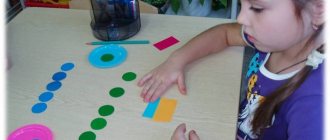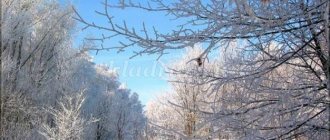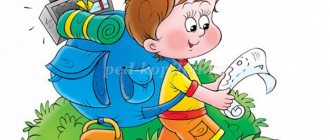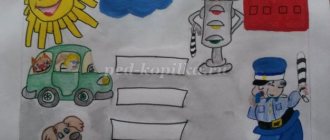Summary of integrated GCD in the second junior group
Summary of an integrated educational activity in the second junior group on the topic “Everyone in the world needs a home”
Author: Anna Nikolaevna Sarapulova, teacher at the kindergarten No. 92, Berezniki, Perm region. Description of the material: I offer you a summary of integrated direct educational activities for children of the second junior group (3-4 years old) on the topic “Everyone in the world needs a home.” The material can be used by the teacher as a final lesson in the second junior group, because corresponds to the level of knowledge of children of this age group at the end of the school year. Integration of educational areas in accordance with FGT: cognition (FEMP), cognition (Formation of a holistic picture of the world, broadening one’s horizons), artistic creativity (Application). Goal: Formation of a holistic, positively rich image of one’s home. Objectives: - expand ideas about wild animals (bear, fox, squirrel), birds, insects; — consolidate knowledge about the properties of materials (paper, fabric, wood); - learn to identify objects of the natural and man-made world; - develop the ability to create object compositions from geometric shapes in appliqué on paper; - develop the ability to operate objects, geometric figures and their combinations: determine quantity, size, shape; navigate in spatial directions away from yourself, in contrasting parts of the day. Demonstration material: model of a wooden hut in blue, paintings depicting low and high houses, soft stuffed toy Bear, logical figures of Dienesh (circles, triangles, squares). Handouts: samples of fabric, paper, wood, material for appliqué (glue, oilcloth, sheets of A5 paper, napkins, forms for gluing). Equipment: monitor, laptop.
Motivational and orientation part:
(Children and teacher sit in a circle on the carpet)
Educator:
We met you again in kindergarten.
Where did you come from to kindergarten? Children's answer. From home. Educator: I also came to kindergarten from home. All children and adults should have a home. Today we will find out what kind of houses there are, and who else, besides people, needs a house. Look what I brought for you to play with. (The teacher shows a model of a wooden house) Children's answer. Little house. Hut. Educator: Who do you think lives in it? Children's answer.
Dolls, toys.
Educator: Yes, this is a dollhouse. A person cannot live in such a house. And why? Children's answer. It is small. Educator: Listen to a poem about him: Look: this is a house - With a roof, walls, a window.
It has both a door and a pipe. The color of the house is blue. Feel free to come into the house! - Do you invite me? Let's go in! (“My House” N. Gol) Main part:
Educator: Let’s look at it carefully. What does our house have? (Children name and show) Children's answer. Roof, walls, chimney, window, door. Educator: You named everything correctly. Every home has such parts. Let's put little tenants in a small house. (Children select and bring dolls or figurines of animals that are the size of the house and put them inside.) Educator: What size houses are they building for people? Children's answer. Big ones. (Children sit on chairs)
Educator: We have pictures on the board depicting houses for people. Let's look at them and compare. (Children look at the pictures of houses on the board: on the left is a one-story house, on the right is a multi-story house) Look at the house that hangs on the left. What can you say about its height? (The teacher runs his hand along the house from bottom to top, showing the height) Children's answer. Low Educator: Look at the house that hangs on the right. What can you say about its height? (The teacher runs his hand along the house from bottom to top, showing the height) Children's answer. Tall Teacher: Well done! The builders built only 1 floor in the low house. This type of house is called a one-story house. And in a tall house there are many floors. This type of house is called multi-storey. Polina, show me a one-story house on the board. How many floors does it have? Child's answer. One. Educator: Nikita, show a multi-story building on the board. How many floors does it have? Child's answer. A lot of. Educator: Let's relax a little and play the game “Building a House.” Physical education based on a poem by N.V. Nishcheva. (Children and teacher perform movements as the poem progresses): One, two, three, four, five! (Clap their hands) Let's build and play. (They squat) We’re building a big house, high, (They stretch their arms up, stand on their toes) We’re putting up windows, we’re building a roof. (They jump on the spot) What a beautiful house - An old gnome will live in it. (Squat) (Children sit on chairs) Educator: Guys, this morning a guest came to our kindergarten. This is the Toed Bear. (The teacher shows the soft stuffed toy Bear) He came to us from the fairy tale “Teremok”. The bear broke the mansion and now the animals have nowhere to live. Mishka wants to build a new house, but does not know what material it will be made of. Shall we help him? Children's answer. Yes. Educator: (The teacher hands out saucers with samples of fabric, paper and wooden blocks to the children). Look for pieces of paper on your saucers. Let's crumple the paper. Happened? What can you say about paper? Children's answer. She hesitates. Educator: Now let's try to break it. What can we say about paper now? Children's answer. She is torn. Educator: And if it rains, what will happen to her? (Teacher shows wet paper) Children's answer. She will get wet. Educator: Correct. Do you think it is possible to build a house out of paper? Why? Children's answer. It is forbidden. It will tear, the house will be wet. Educator: Well done! Now find a piece of fabric in your saucers. Let's try to crush it. Happened? What can you say about the fabric? Children's answer. She hesitates. Educator: Now let's try to break it. What can we say about the fabric now? Children's answer. She doesn't break. Educator: The fabric is not torn. It is stronger than paper. Let's try to knock on the table with it. Happened? Why? Children's answer. She's soft. Educator: And if we put the fabric in water, what will happen to it? Children's answer. She will get wet. Educator: Do we need this kind of material for our home? Children's answer. No. Educator: Now take the wooden blocks. Let's remember the tree. What can you say about the tree? Children's answer. Doesn't wrinkle. Educator: Try to tear the tree. Happened? What can you say about the tree? Children's answer. It doesn't tear. Educator: Tap the stick on the table. Happened? What can you say about the tree? Is it hard or soft? Children's answer. Solid. Educator: Correct. And even if you put it in water, it will remain just as hard and durable. (The teacher shows the children a block taken out of the water) What material is better to build a tower from: paper, fabric or wood? Children's answer. Made of wood. Educator: Home is very important for a person. Mom and dad, a soft crib and our favorite toys are waiting for us at home. The house is cozy and warm. At home you can relax, receive guests, gather at one table with the whole family and drink tea. Guys, not only people need a house, but also animals, birds, and insects! It protects them from danger, from rain, from cold. (Children and the teacher sit near the screen and get acquainted with the presentation “Everyone in the world needs a home” about the homes of some animals, insects, birds, and aquatic inhabitants) Example of slides:
Educator: Do you remember what the bees' house is called? Children's answer. Hive. Educator: Correct. Now let's turn into little bees and play the game "Find your hive." Outdoor game “Find your hive” Children choose a red, yellow or green flag. Circles are laid out on the floor - beehives of the same colors. Educator: Morning came, the bees woke up and flew to the clearing to collect nectar. (Children spin around the clearing) Evening has come. The sun hid. Bees, fly to your hive! (Children run to the circle of their color) Next, the teacher approaches each hive: “Bees, name your color.” The children of each hive name the color of their house in unison. Educator: Well done, guys! Come to the table. Here I have laid out the figures and houses (paper cones) for these figures. What shapes do you recognize? Children's answer. Circle, square, triangle. Educator: You named everything correctly. How many houses are there on the table? Children's answer. A lot of. Educator: How many figures are on the table? Children's answer. A lot of. Educator: Take one of any figure and hide it in your house. All the houses are occupied, and there are still some extra pieces left. What are more figures or houses? Children's answer. Figure Educator: What is smaller – houses or figures? Children's answer. Domikov. Educator: Let these figures turn into ants. And we will help them get to the anthills.
Didactic game “Help the Ants” (Nosova E.A., Nepomnyashchaya R.L. Logic and mathematics for preschoolers - 2nd ed. - St. Petersburg: Detstvo-Press, 2002) Each child receives an anthill - a cone. The presenter names which ants should hide in the houses (for example, red ones), and the children hide the corresponding Dienesh figures under their cone houses. At the end, the houses are opened and checked to see if a figure (ant) of a different color has entered there. After checking and correcting errors, the figures are returned to their place. The leader gives a new command: hide for the big ants (either not round or not yellow). Educator: Well done, guys! Sit down at the tables. I suggest you make an applique. We will glue the house for the dog. (The teacher shows the children the finished work) What is it called? Children's answer. Booth. Educator: Who made the doghouse - man or nature? Children's answer. Human. Educator: Of course, that means this is an object of the man-made world or the natural world? Children's answer. Man-made. Educator: You have figures laid out in plates.
We will make a booth from a square, glue a triangular roof on top, and make an entrance to the house from a circle. (Children make an applique “Dog Kennel”) Reflective-evaluative part
Educator: I invite everyone to our circle to remember what we learned new today. (Children sit on the carpet in a circle, remember, prepare for reflection) What did we talk about today? Children's answer. About the house, about the mansion, about animals. Educator: (Addressing the child) What did you learn today? Children's answer. Glue the booth. Educator: What did you learn new about houses today? What are they? Children's answer. They are single-story and multi-story. Educator: Who in the world needs a home? Children's answer. People, squirrel, bird, bear, hermit crab, fox. (The teacher summarizes the children’s answers) Educator: Where does the bear winter? Children's answer. In the den. Educator: Try to say in full sentence: The bear spends the winter in a den. (The child repeats after the teacher) Tell me, where does the squirrel live? Children's answer. In the hollow. Educator: Correct. First I will say, and then you will say: The squirrel lives in a hollow. (The child repeats after the teacher) Educator: Who did we help choose the material for the new tower? Children's answer. To the bear. Educator: What did we advise the bear to build a tower from? Children's answer. Made of wood. Educator: That's right, well done, guys! Our lesson is over.
We recommend watching:
Summary of a game (integrated) lesson on environmental education for the 2nd junior group. Methodological development of a summary of an integrated lesson for children of the junior group. Summary of direct educational activities in the first junior group. Synopsis of GCD in the junior group on traffic rules.
Similar articles:
Summary of the integrated lesson “The Adventures of Kolobok” in the junior group
Plan - summary of the lesson on FCCM in the 2nd junior group Topic: “We are girls and boys”
Plan - summary of the lesson on FCCM in the 2nd junior group
Subject:
"We are girls and boys"
Target:
To consolidate the knowledge of preschoolers that in a group there are girls and boys, each of whom can have a different mood: cheerful and sad.
Tasks:
1.
Teach children to distinguish peers by appearance: determine who is a boy and who is a girl.
2.
Reinforce knowledge of children's names in the group.
3.
Cultivate goodwill and polite attitude towards each other.
4.
Develop observation skills and the ability to navigate the group space.
Kind of activity:
gaming, communicative, educational and research, musical and artistic.
Integration of educational areas:
— artistic and aesthetic development, speech development, physical development, social and communicative development, cognitive development.
Materials and equipment:
dolls: boy Vanya, girl Tanya, photographs of children with different emotions: crying, laughing, physical exercise “Little legs ran along the path”, audio recording of the song “Smile”.
Progress of the lesson
- Surprise moment
Children sit in a semicircle on chairs. There is a knock on the door. The teacher brings in two dolls: one of which is a girl doll and one of which is a boy doll.
Educator:
Guys, who came to visit us?
Children:
dolls
Educator:
What should well-mannered children do when guests come?
Children:
greet
(Children greet the dolls loudly)
Educator:
And now, I propose to meet our guests.
(names dolls by name)
Educator:
Vanechka and Tanechka came to us.
Teacher: ( offers to guess which of the dolls is Vanya and which is Tanya)
Which one do you think is Tanya and which one is Vanya? Why?
Children justify their answers by paying attention to the clothes and hairstyle of the dolls when examining them.
- Introducing the concepts: “boy, girl”
Educator:
That's right, well done. And we also have boys and girls in our group. Now the girls will stand near their chairs. We will admire them: what braids they have, elegant dresses.
- And now the boys will get up: look at their smart T-shirts and shorts.
-And now we will check which of you will complete the task faster: boys or girls.
3. Game "Boys and Girls"
Educator:
I suggest playing
the game “Boys and Girls”
(
the teacher places dolls on chairs. Children should stand around each of them: boys around Vanya, and girls around Tanechka)
Teacher :
And now we will check whether our children know their names as well as our guests know them.
( the teacher asks the children to take the doll one by one. And asks questions)
-
Who is holding Tanya in his hands? Is he a girl or a boy?
- Who has Vanechka?
- Which one of us is Ignat? Is he a boy or a girl?
— Is the Vanya doll a boy or a girl?
Educator:
Well done, both girls and boys completed the task. And now we will relax: we will dance and sing.
- Physical exercise “Little legs ran along the path”
Children perform movements to music
5. Introducing the concept of “Sad and Happy”
The teacher
shows the sad doll Tanya, Tanya cries):
We are all different, and we have different moods: sad and cheerful. Guess what our Tanya’s mood is now.
Children:
sad.
Educator
: How did you guess? Tell me.
.
Educator:
What needs to be done to make Tanya cheer up and her mood to become cheerful?
Children:
Feel sorry for her, give her a gift, sing a song.
The teacher offers to console Tanya
6. Game “Guess the mood”
The teacher shows the children photographs of laughing and crying children and asks them to guess the mood.
-Who is shown in the photo?
- What is he doing?
-What is his mood?
— What needs to be done to make the boy’s mood cheerful?
The teacher offers to listen to
the song “Smile” , and who knows, sing along.
7. Summary of the lesson
Educator:
Who is our guest today? What are their names?
- What’s your mood today?




